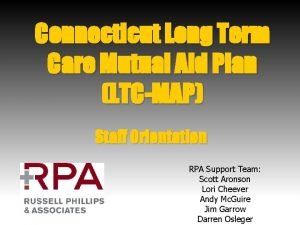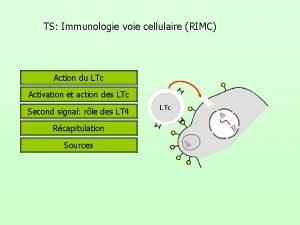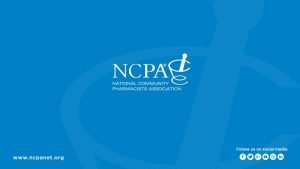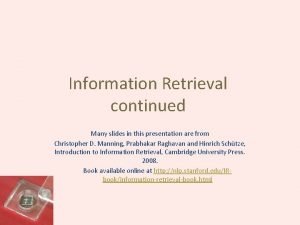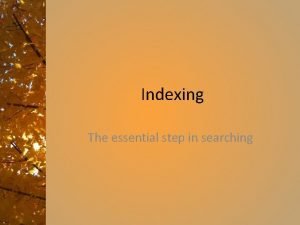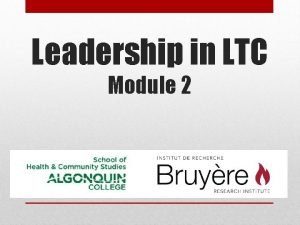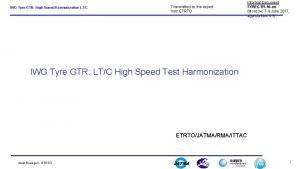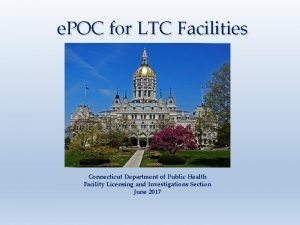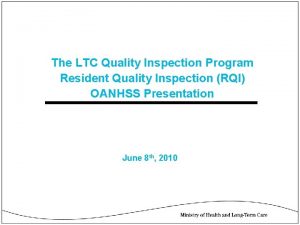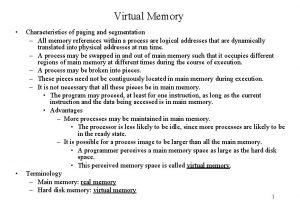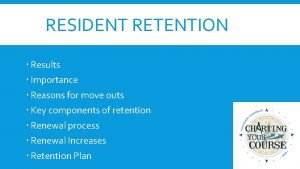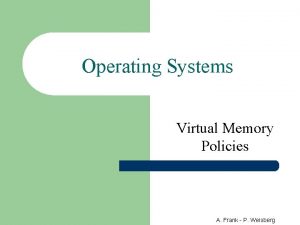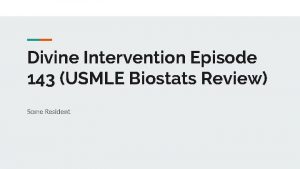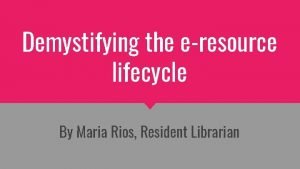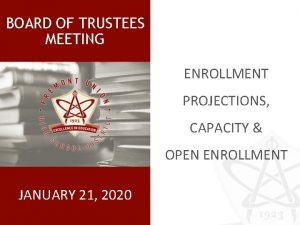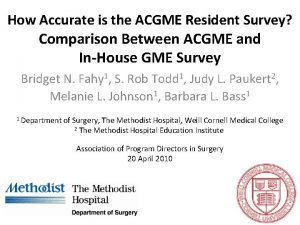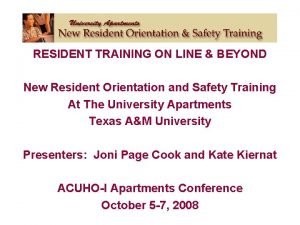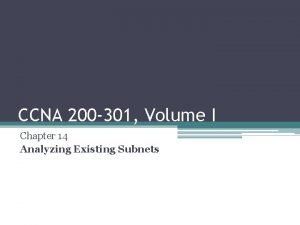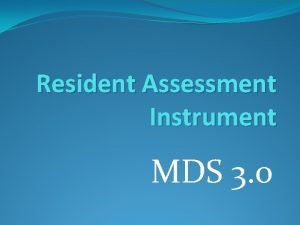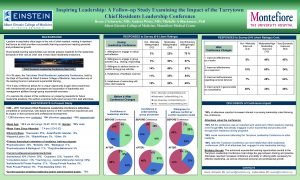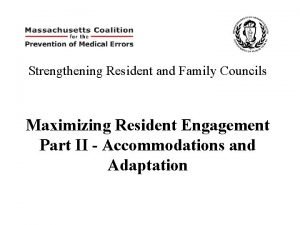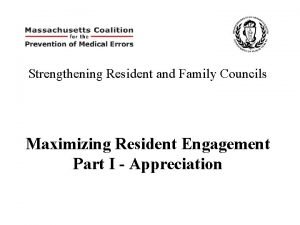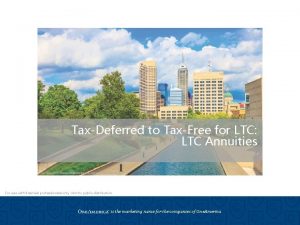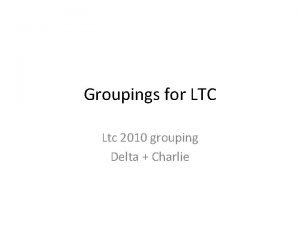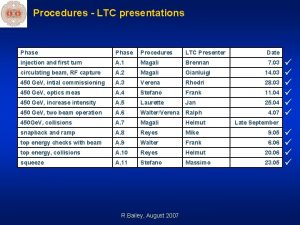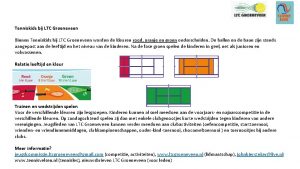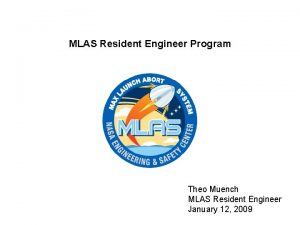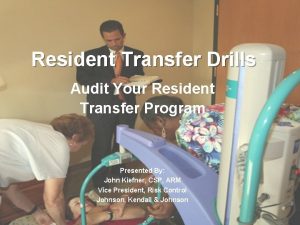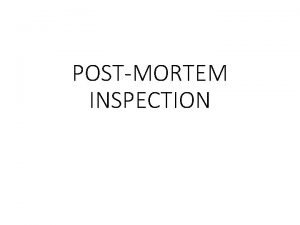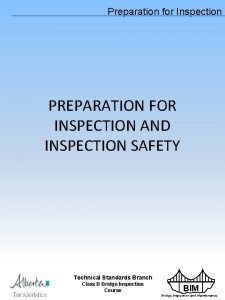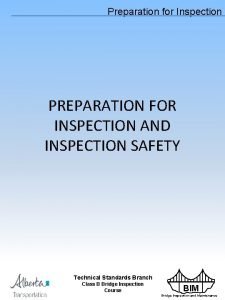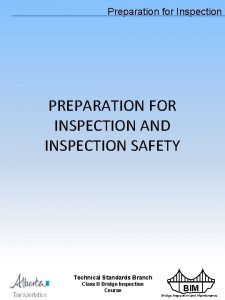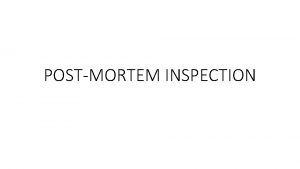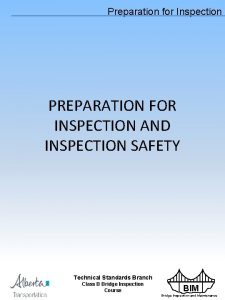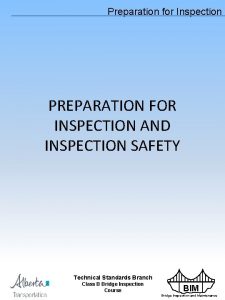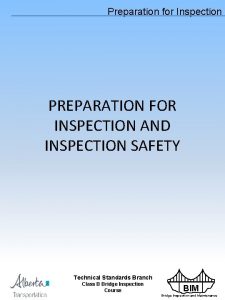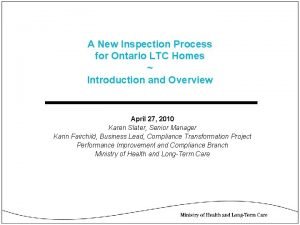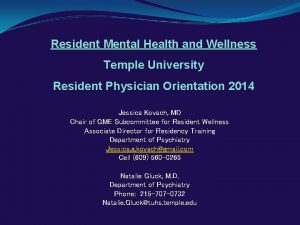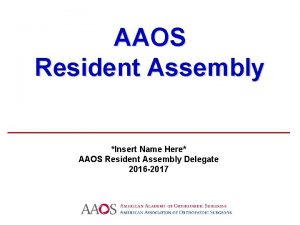The LTC Quality Inspection Program Resident Quality Inspection

































- Slides: 33

The LTC Quality Inspection Program Resident Quality Inspection (RQI) OANHSS Presentation June 8 th, 2010

Agenda • The LTC Quality Agenda • An Overview of the new inspection process • Stage 1 Process • Stage 2 Process • Description of Inspection Protocols • Feasibility Testing • Will it work? • Next Steps • Questions

The Long-Term Care Homes Quality Agenda: Context • The Long-Term Care Homes Act (LTCHA) provides the legislative authority to protect resident rights and supports LTC Homes to provide resident-centred care in a safe and home like environment. This act is to be supported by a strong compliance, inspection and enforcement system • Other initiatives that are also supporting improvements to quality of care in Long Term Care Homes include: - RAI-MDS implementation - Residents First - Capital Redevelopment projects - Other investments as they are announced

Overview – RQI – a new inspection process for LTC Homes in Ontario: The new evidence-based inspection process improves objectivity, consistency and effective decision making where sanctions may be warranted Engages residents and families directly and has a focus on resident quality of life and quality of care Follows a clear approach. This allows homes to focus on residents and plan for on-going improvements

What are we doing? We are: Transforming the inspection process to: • Align with requirements of the Long-Term Care Homes Act, 2007 (LTCHA) and regulation to be proclaimed on July 1, 2010 • Ensure that the over 75, 000 residents in LTC homes continue to be protected and cared for, and their dignity and rights respected • • • Provide confidence in our inspection process to: - Residents - Families - The public - LTC home and ministry compliance staff Reduce variability and inconsistency Support the sector in its effort to deliver quality care Enhance the ability to identify and mitigate risks Establish the foundation for CQI within compliance management

RQI - a made in Ontario solution (based on QIS) Stage 1: Annual Inspections (Standardized on QIS) • Resident, family and staff interviews • Residents’ Council and Family Council interviews • Team inspections • Standard sample of residents randomly selected from RAI-MDS data feed • Mandatory audits for core requirements • Data is categorized and compared against pre-set thresholds • Aligned to LTCHA with adaptations and Ontario thresholds validated through field tests • If thresholds are exceeded, compliance with minimum standards in resident care areas and practices may be at risk, triggering a further inspection protocol for Stage 2 • System includes extensive training and reliability checks for inspectors

RQI - a made in Ontario solution (based on QIS) Stage 2: All Inspections (i. e. annual, complaint, critical incident and follow up) • Care areas and inspection protocols map to LTCHA regulations (protocols will be made available to providers) • Inspector is able to determine if there is non-compliance (deficient practice) • Uses internally developed automated tool to complete detailed inspection protocols and summarize evidence data • Generates inspection report • Enables inspector to identify sanctions, including orders

Overview of the RQI Process Analysis & Decision Making Judgment Matrix Exit Conference Stage 2 In-depth Inspection Stage 1 Preliminary Inspection Triggered Home Related Inspection Resident Care Related Inspection Onsite Inspection Preparation Offsite Inspection Preparation Mandatory Home Inspection Mandatory Home Related Reviews Sample Reviews Interviews: Residents, Families/Significant Others & Staff Observation of the Resident Record Review Stage 1 Sample Selection (Census, Convalescent Care and RAI-MDS) Home Tour Entrance Conference

Abaqis: Group RI 9

Abaqis: Resident Interview Report 10

Abaqis: Summary Report 11

Annual Inspection - Stage 1 • Quality Indicator Inspection (QII) • Preliminary statistical assessment of regulatory areas to determine Care Areas that warrant Stage 2 in-depth inspection • Pre-decisional. No compliance decisions are made in Stage 1 • Inspections will be recorded on tablet computers • Provides summary of inspection activities for monitoring by the ministry 12

Stage 1 Samples 1. Census Sample • random long-stay sample of current residents in the home (n=40), including post-admission care 2. Convalescent Care Sample • only conducted in homes with convalescent beds • random sample of convalescent care residents in past 12 months (n = 30) 3. MDS Sample • all residents (except very recent) with an MDS within the prior six months of the inspection 13

Stage 1: Preliminary Inspection 1. Census Sample • Interviews • - Residents - all interviewable residents - Family - 3 (non-interviewable residents) - Staff - all residents Observation - all residents Clinical record reviews (with new admission and hospitalization) - all residents 2. Convalescent Care Sample • Clinical record reviews (current and discharged residents) 3. MDS Sample • Analysis of quality of care and life indicators from MDS and risk indicators 14

Resident Screening Questions • Are you from around here? • Tell me a little about yourself? • How long have you been here? • What is the food like here? 15

Family Screening Questions 1. With whom did your relative/friend live with before coming to the home? If the resident did not live with you, how often did you see him/her? 2. Are you familiar with his/her preferences and daily routines when s/he was more independent and more able to make choices and express preferences? 3. How often do you visit the resident now? When do you visit (time of day, day of the week) 16

Thresholds • The rate established to govern the decision of whether to conduct an in-depth Stage 2 inspection • Value is absolute, not relative • Rate is for the LTC home, not the resident 17

Areas that may be triggered for a Stage 2 inspection • • • • Abuse Accidents Activities ADL, ROM , Cleanliness and Grooming, Positioning Admission, Transfer and Discharge Behavioural and Emotional Status Bowel and Bladder Function, use of Catheter Choices Communication and Sensory, Hearing and Vision Dental Status and Services Dignity Dining Environment Fecal Impaction Food Quality • • • • • Fecal Impaction Food Quality Hospitalization or Death Infections (non-UTI related) Notification of Change Nutrition, Hydration, Tube Feeding Pain Management Participation in Care Plan Personal Funds Physical Restraints Pressure Ulcers Privacy Psychotropic Medications Rehabilitation and Community Discharge Skin Conditions (non-pressure related) Social Services Personal Property 18

Stage 2 In-depth Inspection • Structured inspections of both resident level and home related issues • Integrate information from multiple sources ˉ Interviews ˉ Observations ˉ Record reviews ˉ Policy and procedure reviews • Rate scope and severity where non compliance is found using judgment matrix 19

Stage 2: Inspection Protocols (IPs) • Tools for in-depth inspection • Use in Stage II annual inspection • Also used for complaint, critical incident and follow up inspections 20

Purpose • Provide guidance to the inspectors in collecting evidence during an inspection • Support the evaluation of compliance with the Long-Term Care Homes Act and its regulations • Provide consistent, organized and systematic review of risks and care outcomes 21

IP Development Process Legal Team Stakeholder Consultation NHQ Team Inspection Protocol Clinical Experts President of Residents’ Council Inspectors during pilot 22

IP Template • Each IP is linked to the Act or regulation • Contains definition / description of key terms • Procedures • Questions are focused on risks and negative care outcomes • Probes are used to guide information collection to determine whether each IP question is compliant or non-compliant • Reflecting inspection best practices: üAssessment üInterviews (resident, family, staff) üRecord Review 23

Resident-Related IP Template • Initial Record Review: RAI-MDS 2. 0 data and other documents review • Resident/Substitute Decision Maker Interview • Staff Interviews Part A: Part B: Resident Risk and Care Outcomes Contributing Factors - optional • Assessment • Contributing Factors: program, training, policies • Plan of Care • Observations / Provision of Care • Monitoring/ Evaluation/ Revision • Other related IP’s if applicable 24

Types of IPs Resident Related Home Related • Triggered • Mandatory 25

Resident-Related IP’s 1. Continence care and bowel management 2. Dignity, choice and privacy 3. Minimizing of restraining 4. Nutrition and hydration 5. Pain 6. Safe and secure home 7. Personal support services 8. Recreation and social activities 9. Responsive behaviours 10. Skin and wound 11. Falls prevention 12. Infection prevention and control 26

Home Related IP’s - Triggered 1. Housekeeping 2. Laundry 3. Maintenance 4. Admission and discharge 5. Critical incident response 8. Hospitalization and death 9. Prevention of abuse and neglect 10. Reporting and complaints 11. Retaliation 6. Emergency plans 12. Snack observation 7. Food quality 13. Sufficient staffing 14. Trust accounts 27

Home Related IP’s - Mandatory 1. Dining observation 2. Infection prevention and control 3. Quality improvement 4. Resident charges 5. Residents’ council interview 6. Family council interview 7. Medication administration 8. Safe and secure home 28

Feasibility Testing: What are we doing to test the new inspection process: • Teams of inspectors, Administrative support and experts from Nursing Home Quality are testing the process over four weeks in eight homes in Ontario • The Stage 1 survey process and Stage 2 Inspection Protocols are being tested to: - Conduct content analysis - Conduct convergence analysis - Conduct specificity and sensitivity analysis - Obtain feedback from residents, families, staff (LTC home and Ministry) 29

Feasibility Testing: Clinical and Statistical Validation • Content validity ˉ Ensures that questions and assessments are relevant and clear ˉ Is the question clear from the respondents’ perspective? ˉ Did the content identify the appropriate areas of concern and risk potential from the inspectors’ perspective? • Predictive validity - Consists of two parts: convergence and sensitivity/specificity analysis - Is there an association between stage 1 and stage 2 consistently? - (convergence analysis) Are stage 1 indicators sensitive enough to identify areas where stage 2 inspection will likely reveal non-compliance ? (sensitivity/specificity analysis) Are thresholds adjusted to desired sensitivity and specificity values? ( Goals are to ensure stage 1 is sensitive enough to identify potential areas of risk and maximize specificity to reduce unnecessary stage 2 inspection) 30

Does it Drive Quality? Will the Results be Accepted? Feasibility Test Stage 1 survey in two LTC homes (June 2009) • Residents and families liked the fact that we were talking with them • LTC home staff felt we were focusing on the right issues • Fit with legislation questions, observations and maps well to LTCHA • Methodology seen as appropriate • Effectively identified potential resident risks in Ontario LTC homes • Stage 2 Feasibility Test planned as part of Ontario adaptation of QIS • Can we update this from current feasibility tests? Feedback from four U. S. homes on QIS experience • Greater fairness, standardization, clarity and focus in the process • Increased number of ‘non-compliances’, each example is a citation • Homes have had to change their Quality Programs to identify, follow up on and address resident and family concerns; quality assurance mechanisms become critical • Education for staff and increased communication within the home is very important • Length of the inspection can be much longer than before. 31

Next Steps: • Revise the questions from the stage 1 inspection process • Revise the inspection protocols in stage 2 • Ensure policies and procedures reflect the steps required to support staff in applying the process consistently • Continue to test, improve and refine the process as the new inspection process is introduced 32

Questions? 33
 Ltc rules for punjab government employees
Ltc rules for punjab government employees Ltc map ct
Ltc map ct Rimc immunologie
Rimc immunologie Selling ltc
Selling ltc Ltc pharmacy gpo
Ltc pharmacy gpo Lnc.ltc example
Lnc.ltc example Lnc.ltc example
Lnc.ltc example Define ltc
Define ltc Ltc tyres
Ltc tyres Uage
Uage Quality inspection program
Quality inspection program Resident set management
Resident set management Resident retention
Resident retention The working set strategy
The working set strategy What is income tax
What is income tax Biostats review
Biostats review Resident lifecycle
Resident lifecycle Chapter 2 foundations of resident care
Chapter 2 foundations of resident care Attending vs resident
Attending vs resident Examples of misappropriation of resident property
Examples of misappropriation of resident property A helpful way for an na to respond to hallucinations is to
A helpful way for an na to respond to hallucinations is to Cna chapter 10 positioning transfers and ambulation
Cna chapter 10 positioning transfers and ambulation Partially resident textures
Partially resident textures Acgme resident survey
Acgme resident survey Employment of non-resident aliens in the philippines
Employment of non-resident aliens in the philippines Telephone 911
Telephone 911 What is conflict resolution in customer service
What is conflict resolution in customer service Define resident flora
Define resident flora Magic mask
Magic mask Resident assessment instrument definition
Resident assessment instrument definition Tarrytown chief resident conference
Tarrytown chief resident conference Transamerica estate planning foreign nationals
Transamerica estate planning foreign nationals Resident and family engagement
Resident and family engagement Resident and family engagement
Resident and family engagement

